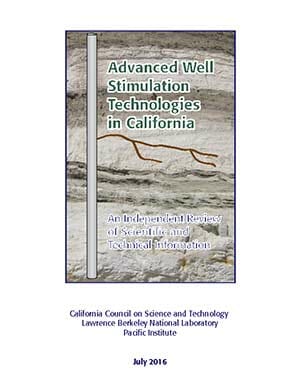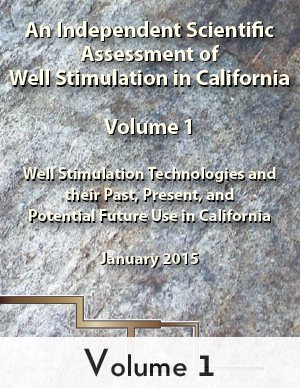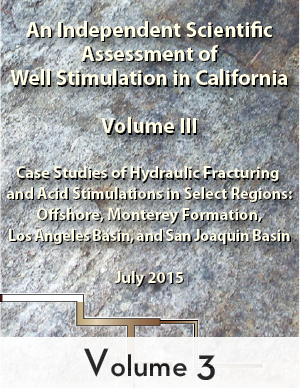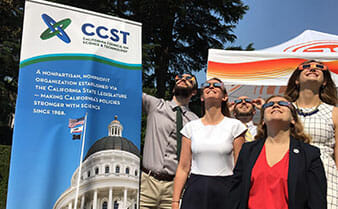An Independent Scientific Assessment of Well Stimulation in California, Vol. 2 (SB4)
Author(s): Long, Jane C.S.; Feinstein, Laura C.; Bachmann, Corinne E.; Birkholzer, Jens T.; Camarillo, Mary Kay; Domen, Jeremy K.; Foxall, William; Houseworth, James E.; Jin, Ling; Jordan, Preston D.; Lindsey, Nathaniel J.; Maddalena, Randy L.; McKone, Thomas E.; Millstein, Dev E.; Reagan, Matthew T.; Sandelin, Whitney L.; Stringfellow, William T.; Varadharajan, Charuleka; Cooley, Heather; Donnelly, Kristina; Heberger, Matthew G.; Hays, Jake; Shonkoff, Seth B.C.; Brandt, Adam; Englander, Jacob G.; Hamdoum, Amro; Nicklisch, Sascha C.T.; Harrison, Robert; Wettstein, Zachary S.; Banbury, Jenner; Cypher, Brian L.; Phillips, Scott E.
Release Date: July 9, 2015 | Last Updated Date: July 22, 2015
Abstract
Pursuant to Senate Bill 4 (Pavley 2013), the California Natural Resources Agency commissioned the California Council on Science and Technology (CCST) to conduct an independent scientific assessment of well stimulation treatments, including hydraulic fracturing, in California.
The purpose of the report is to synthesize and assess the available scientific information associated with well stimulation treatments (WST) in California. The review will survey hydraulic fracturing, matrix acidizing, and acid fracturing as they are applied both onshore and offshore for oil and gas production in the state. The study workscope is organized in three major areas, which are being documented in three separate report volumes.
Volume II discusses how well stimulation could affect water, atmosphere, seismic activity, wildlife and vegetation, and human health. Volume II reviews available data, and identifies knowledge gaps and alternative practices that could avoid or mitigate these possible impacts. For more information on this project, click here.
Additional Downloads
Executive Summary (All Volumes)
Summary Report (All Volumes)
Vol. 2 Front Matter
Vol. 2 Chapter 1
Vol. 2 Chapter 2
Vol. 2 Chapter 3
Vol. 2 Chapter 4
Vol. 2 Chapter 5
Vol. 2 Chapter 6
Vol. 2 General Appendices: A (SB4 Language Mandating Study); B (CCST Steering Committee Members); C (Report Author Biosketches); D (Glossary); E (Review of Information Sources); F (CCST Study Process); G (Expert Oversight & Review)
Chapter 2 Appendices
Chapter 4 Appendices
Chapter 5 Appendices
Chapter 6 Appendices
Appendix 2.G: Data on Wastewater Disposal Ponds (ONLINE ONLY)
Data file (XLS) Data File (CSV)
Appendix 5.E: Estimate of the Number Hydraulic Fracturing Operations by Pool in California (ONLINE ONLY)
Data file (XLS) Data File (CSV)
Table 6.B-1: Chronic Hazard Screening Criteria, Inhalation Route (ONLINE ONLY)
Data file (XLS) Data File (CSV)
Table 6.B-2, Chronic Hazard Screening Criteria, Oral Route (ONLINE ONLY)
Data file (XLS) Data File (CSV)
Table 6.C-1: Hazard Screening Matrix for Acute Human Health Effects of Well Stimulation Fluid Substance (ONLINE ONLY)
Data file (XLS) Data File (CSV)
Table 6.C-2: Hazard Screening Matrix for Chronic Human Health Effects of Well Stimulation Fluid Substances (ONLINE ONLY)
Data file (XLS) Data File (CSV)
Table 6.C-3: Hazard Screening Matrix for Acute Human Health Effects of SCAQMD Acidization Fluid Substances (ONLINE ONLY)
Data file (XLS) Data File (CSV)






